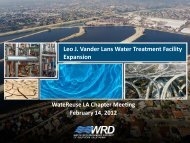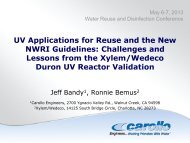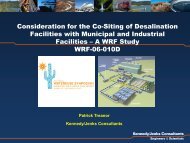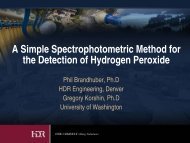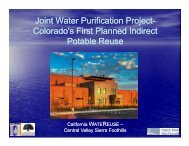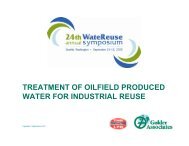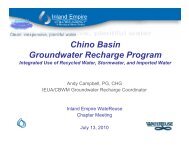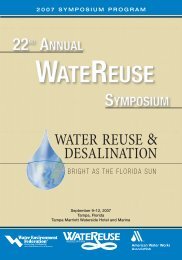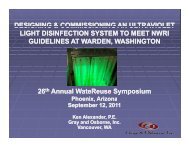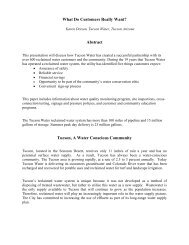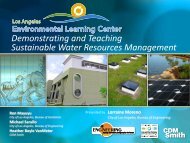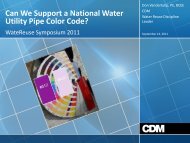Desalination Plant Intakes - WateReuse Association
Desalination Plant Intakes - WateReuse Association
Desalination Plant Intakes - WateReuse Association
You also want an ePaper? Increase the reach of your titles
YUMPU automatically turns print PDFs into web optimized ePapers that Google loves.
such specific example of dramatic environmental impact is the reduction of the habitat of deltasmelt as a result of over-pumping caused by California State Water Project’s intake facilities. 8Such long-term fresh water transfers have affected the ecological stability in the fresh waterhabitats to the extent that the long-term continuation of current water supply practices may resultin significant and irreversible damage of the ecosystems of traditional fresh water supply sourcesand even the intrusion of saline water into the freshwater aquifers, such as the case in SalinasValley, Monterey County, California. In such instances, the environmental impacts ofconstruction and operation of new seawater desalination projects should be weighed against theenvironmentally damaging consequences from the continued expansion of the existing freshwatersupply practices.A responsible approach to water supply management must ensure that sustainable and droughtprooflocal supplies are available, and long-term reliance on conventional water supply sources(i.e., surface water, groundwater) is reconsidered in favor of a well-balanced and diversifiedwater supply portfolio which combines surface water, groundwater, recycled water, waterconservation, and desalination. For example, this type of reliability-driven, balanced watersupply program is currently implemented by West Basin Municipal Water District(www.westbasin.org), the Texas Water Development Board, Tampa Bay Water, and otheragencies in the United States.IMPINGEMENT AND ENTRAINMENT SOLUTIONSWhile impingement and entrainment associated with seawater intake operations are not expectedto create biologically significant impacts under most circumstances, best available site, design,technology, and when needed, mitigation measures, are prudent for minimizing loss of marinelife and maintaining the productivity and vitality of the aquatic environment in the vicinity of theintake.Prudent Open Intake DesignInstallation of Intake Inlet Structure Outside of the Littoral Zone<strong>Intakes</strong> in the littoral zone (i.e., the near-shore zone encompassed by low and high tide levels)have the greatest potential to cause elevated impingement and entrainment impacts. The US EPAconsiders extending intakes 125 meters (410 feet) outside of the littoral zone a good engineeringpractice aimed at reduced impingement and entrainment 9 . According to the Office of NavalResearch, the littoral zone extends 600 feet from the shore 10 . Thus, intakes with an inlet structurelocated at least 1100 feet from the shore could result in reduced environmental impacts. Inaddition, installing the intake to depths where there is a lower concentration of living organisms8 http://www.science.calwater.ca.gov/pdf/eco_restor_delta_smelt.pdf9 http://water.epa.gov/lawsregs/lawsguidance/cwa/316b/phase1/upload/2009_04_02_316b_phase1_support_contents.pdf10 http://www.onr.navy.mil/focus/ocean/regions/littoralzone1.htmSeawater <strong>Desalination</strong> <strong>Plant</strong> <strong>Intakes</strong> – Impingement and Entrainment Page 7



